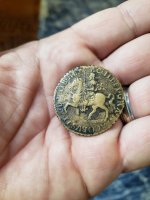Nick79
Hero Member
- Jan 28, 2018
- 761
- 1,920
- 🏆 Honorable Mentions:
- 1
- Detector(s) used
- Equinox 800
- Primary Interest:
- Relic Hunting
Hi all,
I got this coin today but was trying to find out more about it. I find the same design as a crown but it says if it has the month written on it mine says may I believe (MAG). Then it is a half crown. But I don't see an example of my design as a half crown. What am I missing?
I got this coin today but was trying to find out more about it. I find the same design as a crown but it says if it has the month written on it mine says may I believe (MAG). Then it is a half crown. But I don't see an example of my design as a half crown. What am I missing?





